Over 70 Jews from around the world headed to Susya last weekend, where they stood with the residents of the West Bank village under threat of demolition against displacement and settler violence.
It was part anti-occupation activism, part Jewish summer camp, part WWOOF and a little reminiscent of young foreigners coming to volunteer on a kibbutz. Over 70 Jews in their 20s and 30s, mostly from English-speaking countries, spent last Friday and Saturday in the impoverished Palestinian village of Khirbet Susya, whose residents are living under a looming threat of a second forced displacement from their homes. The first time was 30 years ago.
It was my second time in the village that week. A few days earlier, I went to cover a solidarity visit by Palestinian Prime Minister Rami Hamdallah and the heads of mission of every single European Union member state. The tent erected by local Palestinian authorities to host their prime minister was still standing when I arrived in Susya on Saturday. This time instead of an assortment of body guards, PA systems and television crews, the large tent was full of sleeping bags and handful of activists painting banners.
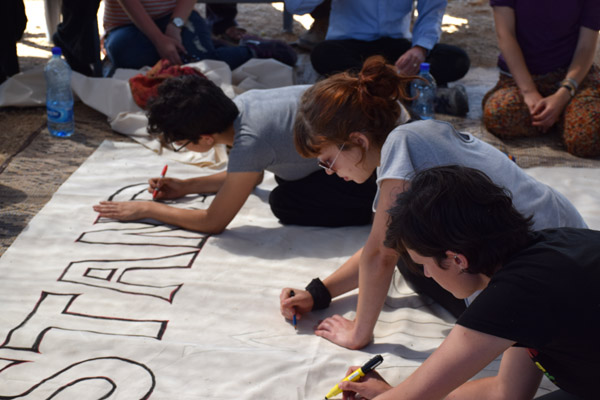
The youngsters came as part of a delegation from a group called All That’s Left. Two and a half years ago, I was among the 15 or so core founders of the group, whose self-defined common denominator was to be “unequivocally opposed to the occupation and committed to building the diaspora angle of resistance.” And although I soon dropped out, I have watched them closely since, curious and often proud of their creative, inspiring activism and seemingly bottomless reserves of energy and optimism.
The trip to Susya had been in the works for months. The plan was to bring as many Jews — and others — somehow connected to overseas communities to the south Hebron Hills, where Palestinians live in a spattering of villages often composed of a few dozen tents without any connection to electricity or running water. Almost all of them are under constant threat of demolition by the Israeli army, and almost all of them are located within a few hundred meters of Israeli settlements that are illegal under international law but protected and provided for by Israel.
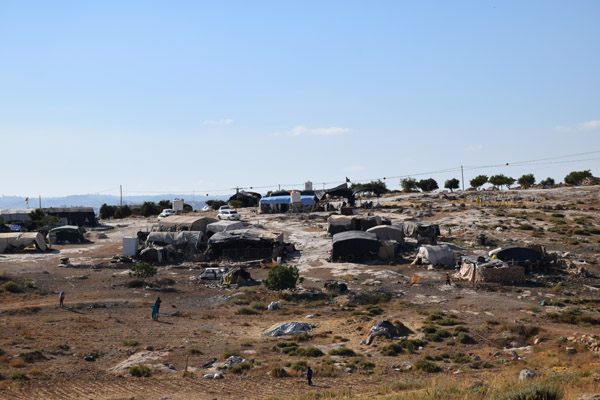
All That’s Left was asked to come, invited by local residents who know the value of solidarity. Susya has become one of the flagship cases of 21st century dispossession in the West Bank. Countless Palestinian, Israeli and international activists, diplomats, artists and many others have come to express their support in recent years. Villagers work closely with organizations like B’Tselem, Rabbis for Human Rights, Ta’ayush and Breaking the Silence. At the official event earlier in the week, the United Nation’s humanitarian coordinator for the West Bank optimistically noted that public campaigns and international efforts have succeeded in preventing planned displacements in the past. Maybe it could work here, too.
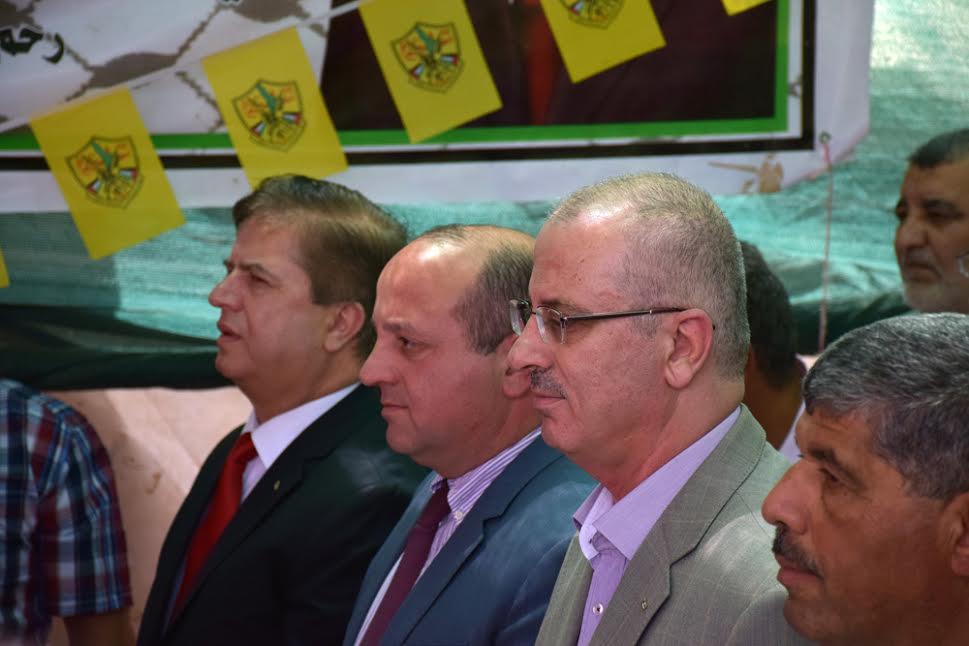
But the primary aim of the two-day visit by the young, mostly American and British Jews, was to make an immediate, tangible and positive impact on the lives of the Palestinian residents of Susya and two neighboring villages, Bir el-Eid and Umm al-Khair. For weeks beforehand they held fundraisers and launched a Kickstarter-type online campaign in order to buy building materials, work tools and plants. The villagers wanted help with two things: repairing their derelict, dirt access roads, and planting new fields of za’atar, a variant of thyme common throughout the Levant.
Early Friday morning, 50 or so All That’s Left members set out from Jerusalem, hoping to get in a few solid work hours before the sun made it impossible to break through the packed earth and move an endless supply of rocks. That night, they slept in the tent erected for the diplomats and Palestinian prime minister.
By the time I arrived Saturday morning, in a bus with two dozen activists and a few +972 bloggers, the volunteers had already left for their day of road flattening in a nearby village. After a short briefing on the problems Susya is facing and the type of work they need help with, we were brought to a small za’atar field with no more than a dozen rows and instructed about which weeds and rocks needed to go and which were “good for the za’atar.” Gardening tools and buckets in hand, the activists got right to work. The atmosphere was energetic — reminiscent of something between a Habitat for Humanity project and foreign Zionist volunteers in the 1950s coming to help “reclaim the land,” albeit this time for Palestinians.
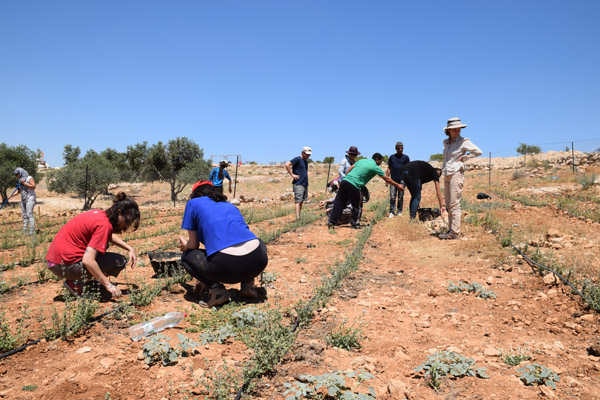
After a couple of hours, though, the sun was bearing down and all but a couple of the volunteers — who were determined to get every last weed — decided that their work was done, sardining themselves into the comically scant shade of a few freshly planted olive trees. A few hours later, the chain-gang contingent returned for lunch and everyone squeezed back into the prime ministerial tent, adorned with left-over Fatah flags and banners of current and former PLO chairmen Abbas and Arafat. As people finished their lunch of bread, vegetables, tahini and — not quite vegan — tuna, the men who had been accompanying us most of the day noticed young settlers coming down the hill from the adjacent settlement that long ago took over not only Susya’s land, but also its name.
Aside from the press event with the politicians and diplomats earlier in the week, all of my previous experience visiting the south Hebron Hills has been while reporting on the work of Ta’ayush, a group that, pretty much on a weekly basis, puts its bodies in between aggressive, violent settlers and Palestinian herders and farmers. The south Hebron Hills is notorious, along with the hill country south of Nablus, as an epicenter of settler violence — the Wild West. This is a place where the Israeli army escorts Palestinian children on their way to school, to protect them from settlers. It is an area where videos of settler violence long ago stopped being a newsworthy phenomenon.
And here they came. The All That’s Left group had received briefings on how to react in case this type of thing happened. Non-violence was key, and nobody really wanted to get arrested — a regular occurrence when left-wing Israeli activists stand between Palestinians, settlers and the often clueless soldiers dispatched to whichever remote, arid valley in which the settlers have decided to make their presence felt that day. The activists there on Saturday ran, or walked quickly toward the interlopers — but everybody stopped short after 100 meters or so when it became clear that they weren’t actually coming to make trouble. Back to tea, and a little bit of group learning.
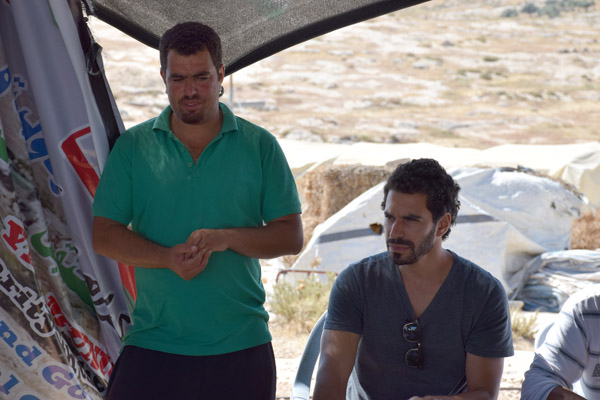
An hour later, however, different settlers were spotted on another hill a couple of small valleys over — this time approaching a patch of olive trees owned by residents of Palestinian Susya. A handful of the Palestinian men and a dozen children start running in their direction. I grab my camera and another dozen of the activists and I follow suit. By the time we arrive the settlers are gone and Nasser, the group’s point man in the village, is talking, distraught and out of breath, to three soldiers who have just arrived.
It seems that a few settlers had come down from the direction of the settlement of Susya and started snapping off branches from the relatively young olive trees. When Nasser approached, they started throwing stones. A lone female soldier who was positioned at a watchtower seemingly in the middle of nowhere and yet smack in the middle of all the action, had tried to tell Nasser to leave. Maybe she told the settlers to leave, too. Either way, nobody really cared. She had to duck to avoid being hit by the stones being thrown by the settlers. Nasser got the whole thing on video.
A few minutes later, a civilian police officer and an officer from the Civil Administration, a nice term for a Military Government, arrived. The police officer looks at the broken olive branches and remarks, “the settlers wouldn’t cut down trees — it’s Shabbat.” But he seems far more interested in the video of the stone throwing. With his cell phone, the cop films the video, interviews the female soldier who witnessed the whole thing, and promises to look for the culprits.
Nobody really takes them seriously. According to research by Israeli human rights organization Yesh Din, only 7.4 percent of Israeli police investigations into settler violence and vandalism against Palestinians result in indictments. More often than not, the official reason cited for closing the investigations is “perpetrator unknown.” In other words, for whatever reason, the police cannot locate a suspect — often times in spite of video evidence and eyewitnesses.
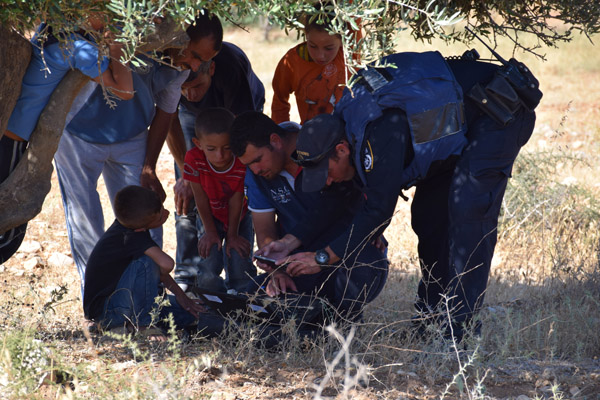
The police left. The army left. Nasser promised to go to the police station later to file an official complaint and hand over a copy of the video. We all headed back across the two cracked valleys toward the tent. It was getting late and the bus was coming soon to take us back to Jerusalem. The organizers of the All That’s Left group started their debrief session, asking participants to talk about their experiences, discussing strategies for moving forward and logistics for the trip home.
At some point I decide to wander toward the main road in order to take some photos, when an army jeep approaches. An officer gets out. A captain. He yells to me, “hey, kiddo! Come over here.” I walk over, not quite knowing what to expect. “Call over Nasser,” he tells me. “We caught the guys who were throwing stones and I want to see his video to make sure it’s them.” A little stunned, I point him in the right direction. The lieutenant doesn’t want to walk into the village. Maybe it’s all the activists, maybe he’s lazy, maybe he doesn’t feel safe. Who knows. Another Palestinian man approaches and, after getting the same explanation, starts yelling for Nasser. Nasser brings over his laptop. In an almost identical scene as before, they crouch below an olive tree to mitigate the harsh glare and watch the video. It’s them, the officer says, adding, “they’re not from here. The people in [the settlement of] Susya don’t want trouble either, you know.” “Sure,” Nasser says with a shrug, promising to bring the video to the police station the next day.
And so it ends. There’s no way of knowing if it would have ended differently had dozens of international and — Jewish — Israeli activists been there that day. It’s clearly an anomaly, but maybe the soldiers and police took their job more seriously that day? Maybe they just got lucky? Maybe the suspects won’t even be charged. It doesn’t really matter. Susya is still facing imminent demolition, its residents in danger of forced displacement. The army wants to move them into Palestinian-controlled cities, out of Area C, the part of the West Bank Israel retains complete control over, and which many in Israel’s government hope to one day annex.
The story of Susya is not extraordinary. The same thing is happening — without dozens of Jewish solidarity activists — in other communities in the south Hebron Hills, in the E1 area near Jerusalem, in the Jordan Valley and even inside the Green Line in villages like Al Araqib. In all of those places, the Israeli army is trying to move Palestinians out in order to move more Jews in, or at least to give them control over more land. Susya is not extraordinary, it is probably not the village that will get the world’s attention. Susya is one story of the occupation. And the solidarity visits, by diplomats, foreign college students or Palestinian and Israeli activists, is one story of resistance.



